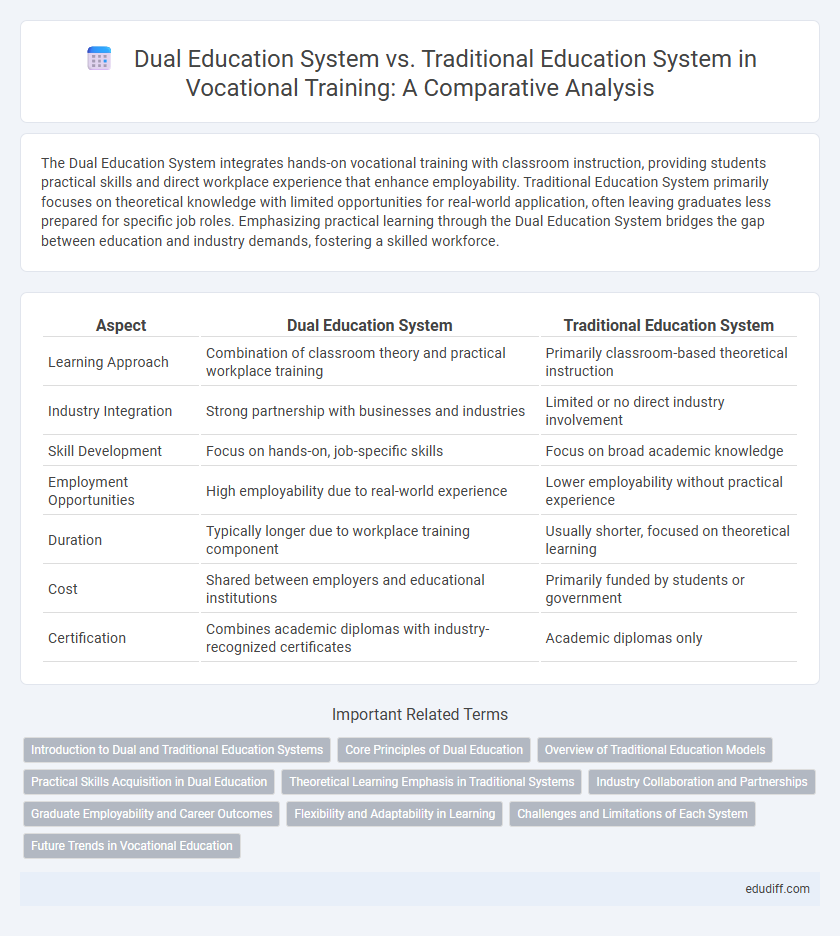The Dual Education System integrates hands-on vocational training with classroom instruction, providing students practical skills and direct workplace experience that enhance employability. Traditional Education System primarily focuses on theoretical knowledge with limited opportunities for real-world application, often leaving graduates less prepared for specific job roles. Emphasizing practical learning through the Dual Education System bridges the gap between education and industry demands, fostering a skilled workforce.
Table of Comparison
| Aspect | Dual Education System | Traditional Education System |
|---|---|---|
| Learning Approach | Combination of classroom theory and practical workplace training | Primarily classroom-based theoretical instruction |
| Industry Integration | Strong partnership with businesses and industries | Limited or no direct industry involvement |
| Skill Development | Focus on hands-on, job-specific skills | Focus on broad academic knowledge |
| Employment Opportunities | High employability due to real-world experience | Lower employability without practical experience |
| Duration | Typically longer due to workplace training component | Usually shorter, focused on theoretical learning |
| Cost | Shared between employers and educational institutions | Primarily funded by students or government |
| Certification | Combines academic diplomas with industry-recognized certificates | Academic diplomas only |
Introduction to Dual and Traditional Education Systems
The Dual Education System combines theoretical classroom instruction with practical on-the-job training, facilitating direct industry experience and skill application. Traditional Education System primarily emphasizes classroom-based theoretical knowledge with limited hands-on practice, often delaying real-world exposure until after graduation. This integrated approach in dual education enhances employability by aligning training with current labor market demands.
Core Principles of Dual Education
The Dual Education System integrates structured on-the-job training with classroom instruction, emphasizing practical skills aligned with industry requirements to enhance employability. Core principles include close cooperation between employers and educational institutions, competency-based learning, and real-world experience through apprenticeships or internships. This model contrasts with traditional education systems, which primarily focus on theoretical knowledge with limited direct workplace exposure.
Overview of Traditional Education Models
Traditional education models emphasize a structured curriculum delivered primarily through classroom instruction, focusing on theoretical knowledge and standardized testing. These systems often lack direct integration with practical work experience, potentially limiting students' job readiness and adaptability in vocational fields. Traditional education tends to prioritize academic subjects over hands-on skills development, which can create gaps in meeting industry demands for skilled labor.
Practical Skills Acquisition in Dual Education
The Dual Education System significantly enhances practical skills acquisition by integrating on-the-job training with classroom instruction, allowing students to apply theoretical knowledge in real-world settings. This hands-on experience fosters deeper understanding and better prepares learners for industry demands compared to the Traditional Education System, which typically emphasizes theoretical learning with limited practical exposure. Companies benefit from this model by shaping workforce-ready professionals who require less on-the-job training post-graduation.
Theoretical Learning Emphasis in Traditional Systems
Traditional education systems prioritize theoretical learning, focusing heavily on classroom instruction and academic knowledge acquisition. This approach emphasizes memorization, conceptual understanding, and standardized testing, often lacking practical skill development. As a result, students may face challenges in applying theoretical concepts to real-world vocational tasks without complementary hands-on experience.
Industry Collaboration and Partnerships
The Dual Education System fosters strong industry collaboration by integrating on-the-job training with classroom learning, ensuring students gain practical skills aligned with employer needs. Partnerships between companies and educational institutions create tailored curricula that respond directly to workforce demands, enhancing employability. In contrast, the Traditional Education System often lacks direct collaboration with industries, resulting in a skills gap and less immediate job readiness for graduates.
Graduate Employability and Career Outcomes
The Dual Education System integrates practical workplace training with academic instruction, significantly enhancing graduate employability by equipping students with industry-relevant skills and experience. In contrast, the Traditional Education System often emphasizes theoretical knowledge, which may result in graduates facing challenges in job readiness and career progression. Studies show that graduates from dual education programs achieve higher employment rates and faster career advancement due to their hands-on expertise and professional network development.
Flexibility and Adaptability in Learning
The Dual Education System enhances flexibility by integrating practical work experiences with theoretical classroom instruction, allowing students to adapt learning to real-world job demands efficiently. Unlike the Traditional Education System, which often follows a fixed curriculum, the dual approach tailors skill development to industry needs, promoting better responsiveness to labor market changes. This adaptability fosters improved employability and accelerates skill acquisition aligned with evolving vocational requirements.
Challenges and Limitations of Each System
The Dual Education System faces challenges such as limited access to qualified training companies and potential mismatch between theoretical knowledge and practical skills, while the Traditional Education System often struggles with outdated curricula and insufficient hands-on experience. Both systems encounter limitations in adaptability to evolving industry demands and varying quality of instruction. Addressing these issues requires integrating industry partnerships for Dual Education and incorporating experiential learning opportunities within Traditional Education frameworks.
Future Trends in Vocational Education
Future trends in vocational education emphasize the integration of the Dual Education System, combining theoretical instruction with practical industry experience to enhance job readiness and skill acquisition. Advanced technologies such as AI-driven simulations and virtual reality are increasingly incorporated to provide immersive, hands-on training environments. This shift supports adaptive learning pathways and stronger partnerships between educational institutions and employers, positioning students for evolving labor market demands.
Dual Education System vs Traditional Education System Infographic

 edudiff.com
edudiff.com